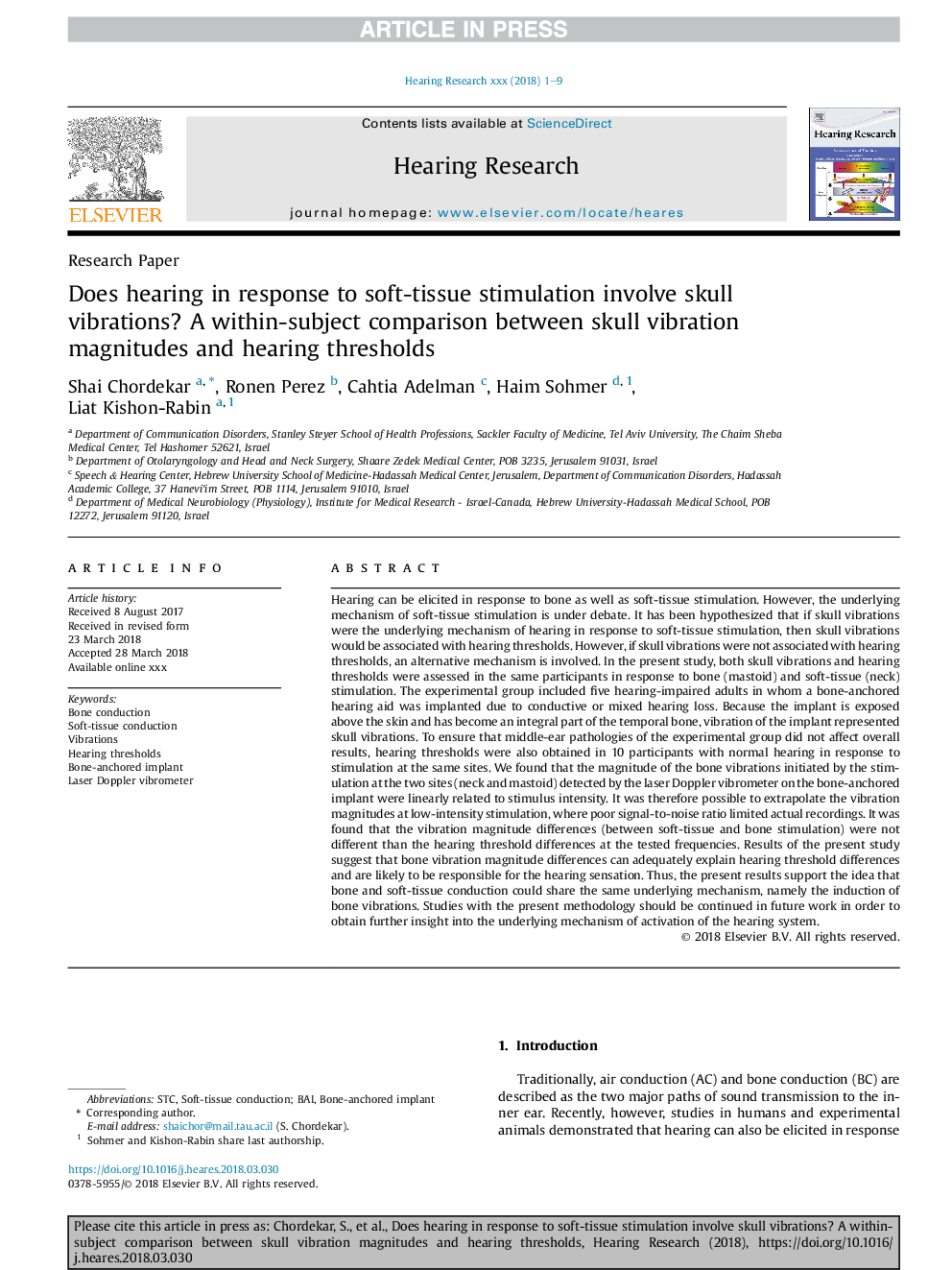| کد مقاله | کد نشریه | سال انتشار | مقاله انگلیسی | نسخه تمام متن |
|---|---|---|---|---|
| 8842355 | 1615536 | 2018 | 9 صفحه PDF | دانلود رایگان |
عنوان انگلیسی مقاله ISI
Does hearing in response to soft-tissue stimulation involve skull vibrations? A within-subject comparison between skull vibration magnitudes and hearing thresholds
ترجمه فارسی عنوان
آیا شنوایی در پاسخ به تحریک بافت نرم شامل ارتعاش جمجمه می شود؟ یک مقایسه درون موضوع بین مقیاس ارتعاش جمجمه و آستانه شنوایی
دانلود مقاله + سفارش ترجمه
دانلود مقاله ISI انگلیسی
رایگان برای ایرانیان
ترجمه چکیده
شنیدن می تواند در پاسخ به استخوان و همچنین تحریک بافت نرم ایجاد شود. با این حال، مکانیزم پایه تحریک بافت نرم در حال بحث است. فرض شده است که اگر ارتعاش جمجمه مکانیسم اساسی شنوایی در پاسخ به تحریک بافت نرم باشد، سپس ارتعاش جمجمه با آستانه شنوایی همراه خواهد بود. با این حال، اگر ارتعاش جمجمه با آستانه شنوایی ارتباط نداشته باشد، یک مکانیزم جایگزین درگیر است. در مطالعه حاضر، ارتعاش جمجمه و آستانه شنوایی در پاسخگویی به تحریک استخوانی (ماستویید) و نرم بافت (گردن) در همان مشارکت کنندگان مورد ارزیابی قرار گرفتند. گروه آزمایشی شامل پنج بزرگسال مبتلا به اختلالات شنوایی بود که در آن یک سمعک استخوان لمس شده به علت کاهش شنوایی هدایت یا مخلوط انجام شد. از آنجایی که ایمپلنت در بالای پوست ظاهر می شود و به عنوان بخشی جدایی ناپذیر از استخوان تمپورال تبدیل شده است، ارتعاش ایمپلنت، ارتعاشات جمجمه را نشان می دهد. برای اطمینان از اینکه آسیب های میانی گوش گروه تجربی نتایج کلی را تحت تاثیر قرار نمی داد، آستانه شنوایی نیز در 10 شرکت کننده با شنوایی طبیعی در پاسخ به تحریک در همان سایت ها به دست آمد. ما دریافتیم که مقدار ارتعاشات استخوانی ناشی از تحریک در دو محل (گردن و ماستوئید) که با استفاده از لیزر داپلر ویبرومتر بر روی ایمپلنت بر پایه استخوانی تشخیص داده شد به طور خطی با شدت تحریک ارتباط داشت. از این رو ممکن است که مقدار ارتعاش را با تحریک کم و شدت در نظر بگیریم، در حالی که نسبت ضعیف سیگنال به نویز، ضبط واقعی را محدود می کند. یافته شد که تفاوتهای ارتعاش (بین بافت نرم و تحریک استخوان) تفاوتی با تفاوت آستانه شنوایی در فرکانسهای آزمایش شده نداشت. نتایج این مطالعه نشان می دهد که تفاوت های ارتعاشات استخوانی می تواند به طور کافی تفاوت های آستانه شنوایی را توضیح دهد و احتمالا مسئول حس شنوایی باشد. بنابراین، نتایج کنونی از این ایده حمایت می کند که هدایت استخوان و بافت نرم می تواند همان مکانیزم پایه، یعنی القای ارتعاشات استخوانی را به اشتراک بگذارد. مطالعات با روش فعلی باید در کارهای آینده ادامه یابد تا بینش بیشتری را در مورد مکانیزم پایه فعال سازی سیستم شنوایی بدست آورند.
موضوعات مرتبط
علوم زیستی و بیوفناوری
علم عصب شناسی
سیستم های حسی
چکیده انگلیسی
Hearing can be elicited in response to bone as well as soft-tissue stimulation. However, the underlying mechanism of soft-tissue stimulation is under debate. It has been hypothesized that if skull vibrations were the underlying mechanism of hearing in response to soft-tissue stimulation, then skull vibrations would be associated with hearing thresholds. However, if skull vibrations were not associated with hearing thresholds, an alternative mechanism is involved. In the present study, both skull vibrations and hearing thresholds were assessed in the same participants in response to bone (mastoid) and soft-tissue (neck) stimulation. The experimental group included five hearing-impaired adults in whom a bone-anchored hearing aid was implanted due to conductive or mixed hearing loss. Because the implant is exposed above the skin and has become an integral part of the temporal bone, vibration of the implant represented skull vibrations. To ensure that middle-ear pathologies of the experimental group did not affect overall results, hearing thresholds were also obtained in 10 participants with normal hearing in response to stimulation at the same sites. We found that the magnitude of the bone vibrations initiated by the stimulation at the two sites (neck and mastoid) detected by the laser Doppler vibrometer on the bone-anchored implant were linearly related to stimulus intensity. It was therefore possible to extrapolate the vibration magnitudes at low-intensity stimulation, where poor signal-to-noise ratio limited actual recordings. It was found that the vibration magnitude differences (between soft-tissue and bone stimulation) were not different than the hearing threshold differences at the tested frequencies. Results of the present study suggest that bone vibration magnitude differences can adequately explain hearing threshold differences and are likely to be responsible for the hearing sensation. Thus, the present results support the idea that bone and soft-tissue conduction could share the same underlying mechanism, namely the induction of bone vibrations. Studies with the present methodology should be continued in future work in order to obtain further insight into the underlying mechanism of activation of the hearing system.
ناشر
Database: Elsevier - ScienceDirect (ساینس دایرکت)
Journal: Hearing Research - Volume 364, July 2018, Pages 59-67
Journal: Hearing Research - Volume 364, July 2018, Pages 59-67
نویسندگان
Shai Chordekar, Ronen Perez, Cahtia Adelman, Haim Sohmer, Liat Kishon-Rabin,
